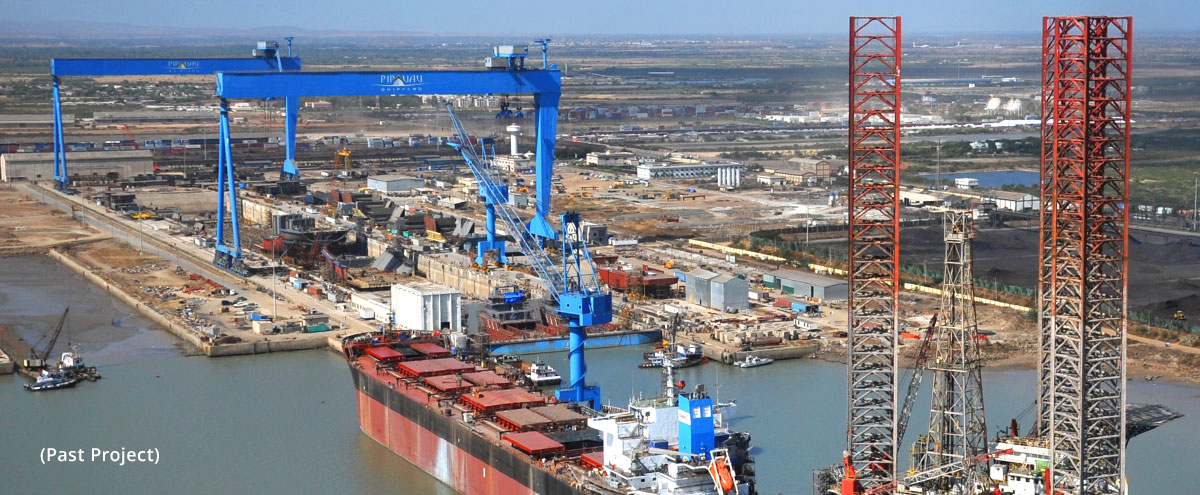
Gujarat shipyards to rise again with business
GANDHINAGAR : The government is now trying to revive Gujarat’s shipyards’ sector by attracting new players and revising the 14-year-old ‘shipbuilding policy’.
A shipyard’s capacity is defined in terms of the number of ships built and the maximum carrying capacity of the built ship, measured in units of dead weight tonnage (DWT).
Until 2014, the state boasted a cumulative annual shipbuilding capacity of over 5.4 lakh DWT. Pipavav, with 4 lakh DWT capacity, was the biggest shipbuilder in the country. ABG Shipyard followed at a distance with 1.2 lakh DWT. Among state-run shipbuilders, Alcock Ashdown, with 15,000 DWT, was the third largest after Hindustan Shipyard (80,000 DWT) and Cochin Shipyard (1.1 lakh DWT). Shipyards in Gujarat could build vessels that were as big as 350 m long and 63 m wide. These included bulk carriers, oil tankers, tugs, barges, offshore supply vessels, floating cranes, pollution control vessels, and naval vessels.
Overflowing order-book
Such was the dominance of Gujarat’s private shipbuilders that, at the beginning of the previous decade, the state accounted for almost 60 per cent of India’s shipbuilding order book. As of March 2014, ABG Shipyard had the highest number of orders — 66 ships with total capacity of 11.69 lakh DWT. Pipavav had orders for 44 ships with 12.23 lakh DWT. Around the same time, public sector shipyards across India together had orders for 101 ships, but with higher capacity of 86.5 lakh DWT.
Towards the end of the year, however, the major shipyards of Gujarat began facing a straitened financial situation. Liquidity crunch, and an inability to honour contracts and survive a downturn in the industry led to the closure of the shipyards. Before the shutdown Pipavav Shipyard had a large workforce (4,993), second only to Mazagon Dock (8,635), as on March 31, 2014. ABG Shipyard had cut its employee strength to 1,321 (from a high of 2,890 in 2010) and Alcock Ashdown’s employee strength fell to 132 from 198.
As the crisis worsened, the government’s plans for greenfield shipbuilding parks at Dahej, Bhavnagar, Chachchi, Adri, Dari and Khara fell by the wayside.
In the decade that followed, only a handful of the smaller players like Modest Infrastructure , Shoft Shipyard, and Wadia Boat Builders managed to remain afloat.
Revival on the cards
Rajkumar Beniwal, Vice-Chairman and CEO of Gujarat Maritime Board (GMB), an apex body for port and port-affiliated developments in the state, is confident of a turnaround in the shipbuilding fortunes. “A recession in the shipbuilding sector forced the larger players to go bankrupt. However, we are now getting a lot of inquiries, with large players from Goa signing agreements during the just concluded Vibrant Gujarat summit to build a shipbuilding and repair facility in the state,” he says.
Five proposals, worth ₹5,200 crore, to build new shipyards in Gujarat were received from entities such as ArcelorMittal Nippon Steel, Mandovi Drydocks, and the less-known Unicorn Docks and Port Engineers. According to state officials, the agreements with the Gujarat government are for future shipbuilding yards at locations like Hazira, Kutch, Bhavnagar and Amreli.
The state, on its part, wants to be better prepared for this new turn of events. “The interest is so high that we are now working on revising our shipbuilding policy, as the older one has become outdated. We are not building many ships now; we hope the sector revives, especially once defence sector companies set up base here,” Beniwal says.
First floated in 2010, the state’s shipbuilding policy has seen few changes since.
‘Cradle to graveyard’ policy
The GMB’s ‘Vision 2047’ document, released during the Vibrant Gujarat summit, speaks about creating a “cradle to graveyard” ecosystem for ships in the state by 2047. The aim is to not only ensure that existing shipyards are “fully operational with advanced capabilities” but also build new yards at Okha and Bhavnagar, create a maritime cluster to support the shipbuilding industry with machinery, parts and raw materials, and establish a ‘free trade warehousing zone’ for storage of spare parts for shipbuilding and repair.
Amit Oza, Director of Astramar Shipping and Trading Services, believes that, rather than seeking domestic investors, the sector must target established shipbuilders from Japan and South Korea.
“India’s shipbuilding capacity is minuscule compared to the global market. Lack of capital and talent plagues the sector in India. China, Japan and South Korea control 90 per cent of the market. As shipbuilding costs have escalated in Japan and South Korea, they have invested in Vietnam and Philippines. The best way is to get one of the big players from either Japan or South Korea to invest in a shipbuilding facility in Gujarat or elsewhere in India,” he suggests.
He also believes that the ship-leasing framework in place at the international financial services centre GIFT City in Gandhinagar can help attract funds to the ailing shipbuilding sector. “A lot of funding for shipbuilding is arranged through the leasing method, where 90 per cent of the cost is financed by a private equity (PE) fund or a combination of PE funds and banks. In such cases a special purpose vehicle is created, which owns the vessel and leases it to the end-user. This is how yards in China, Japan and South Korea manage to get orders, because the people who have the operational expertise do not have the money to buy the ships outright. So, conditions must be created in GIFT City to enable leasing for ship orders.”
